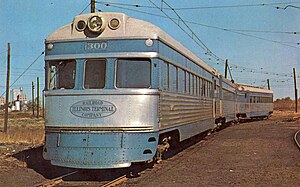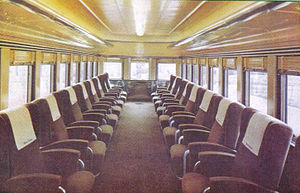| Streamliners | |
|---|---|
 ITC
No. 300, one of the three streamliners | |
 Coach interior | |
| In service | 1948–1956 |
| Manufacturer | St. Louis Car Company |
| Number built | 3 |
| Formation | 3-car set |
| Operators | Illinois Terminal Railroad |
| Specifications | |
| Car body construction | Aluminium |
| Maximum speed | 80 miles per hour (130 km/h) |
| Traction system | Electric |
| Traction motors | 4 × GE 1240A2 |
| Power output | 4 × 140 horsepower (100 kW) |
| Electric system(s) | 600 V DC |
| Current collector(s) | trolley pole |
| Bogies | General Steel Castings |
| Track gauge | 4 ft 8+1⁄2 in (1,435 mm) standard gauge |
| Notes/references | |
| [1] [2] | |
The Streamliners were a fleet of three streamlined electric multiple units built by the St. Louis Car Company for the Illinois Terminal Railroad in 1948–1949. They operated primarily between St. Louis, Missouri and Peoria, Illinois in the late 1940s and early to mid-1950s. They were the last interurban cars manufactured in the United States. [3]
Design
The St. Louis Car Company constructed all three sets. [2] Each equipment set comprised three cars. The cars were constructed of fluted aluminum and were painted in a royal blue paint schene.
Each car was independently powered by four General Electric 1240A2 traction motors, producing 140 horsepower (100 kW) each, and this allowed for a top speed of 80 miles per hour (130 km/h). [1] These traction motors were supplied with traction current via overhead wires, reaching the unit through a trolley pole.
The twin axle bogies for the sets were manufacturer by General Steel Casting's.
Service
The streamliners represented a last attempt by the Illinois Terminal to regain lost passenger traffic and were the first new passenger cars the railroad had ordered since 1918. [4] The Illinois Terminal began teasing the new streamliners in 1947, but did not announce the order until May 1948. Its original plan was to place all three in service between St. Louis and Peoria. [5] [6] The first new train in service was the City of Decatur, which began operating between St. Louis, Missouri and Decatur, Illinois (not Peoria) on November 7, 1948. It was the first through service offered by the Illinois Terminal between those two cities. [1] [7]
By March 1950 all three sets were in operation. The other two, the Fort Crevecoeur and Mound City, were on the St. Louis–Peoria route as originally planned. All three trains offered parlor and " À la carte" dining service. The two streamliners made the trip in 4 hours 40 minutes, forty minutes faster than conventional interurbans on the route. [8] Poor patronage led the Illinois Terminal to withdraw the City of Decatur in August 1950; the equipment was reassigned to the Peoria run. [9] The new service was named Sangamon, which was the railroad's original choice in 1947. [5] [10]
All three sets were withdrawn by 1956 when passenger service on the Illinois Terminal ended. [11]
See also
Notes
- ^ a b c Anderson 1948, p. 10
- ^ a b Schafer 2003, p. 70
- ^ Middleton 1961, p. 420
- ^ Middleton 1961, p. 201
- ^
a
b
"Advertisement".
Edwardsville Intelligencer. January 27, 1947. p. 5. Retrieved August 31, 2014 – via
Newspapers.com.

-
^
"Illinois Terminal Orders Three Streamline Trains".
Edwardsville Intelligencer. May 29, 1948. p. 1. Retrieved August 31, 2014 – via
Newspapers.com.

-
^
"New Terminal Train To Be Shown Here".
Edwardsville Intelligencer. October 19, 1948. p. 1. Retrieved August 31, 2014 – via
Newspapers.com.

- ^ Official Guide of the Railways. New York: National Railway Publication Co. March 1950. p. 1198. OCLC 6340864.
-
^
"Terminal Discontinues Streamliners Nos. 91, 94".
Edwardsville Intelligencer. August 22, 1950. p. 2. Retrieved August 31, 2014 – via
Newspapers.com.

-
^
"Advertisement".
Edwardsville Intelligencer. December 7, 1950. p. 3. Retrieved August 31, 2014 – via
Newspapers.com.

- ^ EuDaly et al. 2009, p. 295
References
- Anderson, Willard V. (December 1948). "Railroad news & editorial comment". Trains. Vol. 9, no. 2. pp. 4–11. ISSN 0041-0934.
- EuDaly, Kevin; et al. (2009). The Complete Book of North American Railroading. Minneapolis: Voyageur Press. ISBN 978-0-7603-2848-4. OCLC 209631579.
- Middleton, William D. (1961). The Interurban Era. Milwaukee, WI: Kalmbach Publishing. ISBN 978-0-89024-003-8. OCLC 4357897 – via Archive.org.
- Schafer, Mike (2003). Classic American Railroads, Volume III. Saint Paul, Minnesota: MBI Publishing. ISBN 978-0-7603-1649-8.
Further reading
- Schafer, Mike (November 2003). "White Elephants under wires". Classic Trains Special Edition. No. 1, Dream Trains. pp. 94–98. ISSN 1541-809X.
External links
-
 Media related to
Streamliners (Illinois Terminal Railroad) at Wikimedia Commons
Media related to
Streamliners (Illinois Terminal Railroad) at Wikimedia Commons - Illinois Traction Terminal Collection, McLean County Museum of History